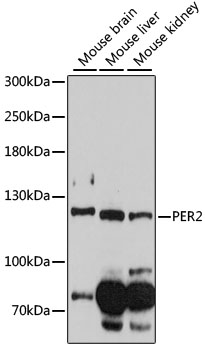Cell Biology Antibodies 4
Anti-PER2 Antibody (CAB14080)
- SKU:
- CAB14080
- Product Type:
- Antibody
- Reactivity:
- Mouse
- Host Species:
- Rabbit
- Isotype:
- IgG
- Antibody Type:
- Polyclonal Antibody
- Research Area:
- Cell Biology
Description
| Antibody Name: | Anti-PER2 Antibody |
| Antibody SKU: | CAB14080 |
| Antibody Size: | 20uL, 50uL, 100uL |
| Application: | WB |
| Reactivity: | Mouse |
| Host Species: | Rabbit |
| Immunogen: | A synthetic peptide corresponding to a sequence within amino acids 1-100 of human PER2 (NP_073728.1). |
| Application: | WB |
| Recommended Dilution: | WB 1:500 - 1:2000 |
| Reactivity: | Mouse |
| Positive Samples: | Mouse brain, Mouse liver, Mouse kidney |
| Immunogen: | A synthetic peptide corresponding to a sequence within amino acids 1-100 of human PER2 (NP_073728.1). |
| Purification Method: | Affinity purification |
| Storage Buffer: | Store at -20'C. Avoid freeze / thaw cycles. Buffer: PBS with 0.02% sodium azide, 50% glycerol, pH7.3. |
| Isotype: | IgG |
| Sequence: | MNGY AEFP PSPS NPTK EPVE PQPS QVPL QEDV DMSS GSSG HETN ENCS TGRD SQGS DCDD SGKE LGML VEPP DARQ SPDT FSLM MAKS EHNP STSG CSSD |
| Gene ID: | 8864 |
| Uniprot: | O15055 |
| Cellular Location: | Cytoplasm, Nucleus, nucleolus, perinuclear region |
| Calculated MW: | 45kDa/136kDa |
| Observed MW: | 136kDa |
| Synonyms: | PER2, FASPS, FASPS1 |
| Background: | This gene is a member of the Period family of genes and is expressed in a circadian pattern in the suprachiasmatic nucleus, the primary circadian pacemaker in the mammalian brain. Genes in this family encode components of the circadian rhythms of locomotor activity, metabolism, and behavior. This gene is upregulated by CLOCK/ARNTL heterodimers but then represses this upregulation in a feedback loop using PER/CRY heterodimers to interact with CLOCK/ARNTL. Polymorphisms in this gene may increase the risk of getting certain cancers and have been linked to sleep disorders. |
| UniProt Protein Function: | PER2: a transcription factor belonging to the basic helix-loop-helix (bHLH) family. A member of the Period family of genes and is expressed in a circadian pattern in the suprachiasmatic nucleus, the primary circadian pacemaker in the mammalian brain. Genes in this family encode components of the circadian rhythms of locomotor activity, metabolism, and behavior. Circadian expression in the suprachiasmatic nucleus continues in constant darkness, and a shift in the light/dark cycle evokes a proportional shift of gene expression in the suprachiasmatic nucleus. Behaves as a negative element in circadian transcriptional loop. Does not appear to bind DNA, suggesting indirect transcriptional inhibition. Expression oscillates with a 24 hr rhythm in the suprachiasmatic nucleus and the whole eyes. Oscillations are maintained under constant darkness and are responsive to changes of the light/dark cycles. There is a 4 hour time delay between per1 and per2 oscillations. The expression rhythms appear to originate from retina. |
| UniProt Protein Details: | Protein type:Nucleolus; Nuclear receptor co-regulator; Transcription factor Chromosomal Location of Human Ortholog: 2q37.3 Cellular Component: cytoplasm; nucleolus; nucleoplasm; nucleus; perinuclear region of cytoplasm Molecular Function:protein binding; transcription coactivator activity; ubiquitin binding Biological Process: circadian regulation of gene expression; circadian rhythm; fatty acid metabolic process; gluconeogenesis; glycogen biosynthetic process; lactate biosynthetic process; negative regulation of circadian rhythm; negative regulation of protein ubiquitination; negative regulation of transcription from RNA polymerase II promoter; negative regulation of transcription, DNA-dependent; regulation of cell cycle; regulation of circadian rhythm; regulation of glutamate uptake during transmission of nerve impulse; regulation of insulin secretion; regulation of neurogenesis; regulation of vasoconstriction; transcription, DNA-dependent; white fat cell differentiation Disease: Advanced Sleep Phase Syndrome, Familial, 1 |
| NCBI Summary: | This gene is a member of the Period family of genes and is expressed in a circadian pattern in the suprachiasmatic nucleus, the primary circadian pacemaker in the mammalian brain. Genes in this family encode components of the circadian rhythms of locomotor activity, metabolism, and behavior. This gene is upregulated by CLOCK/ARNTL heterodimers but then represses this upregulation in a feedback loop using PER/CRY heterodimers to interact with CLOCK/ARNTL. Polymorphisms in this gene may increase the risk of getting certain cancers and have been linked to sleep disorders. [provided by RefSeq, Jan 2014] |
| UniProt Code: | O15055 |
| NCBI GenInfo Identifier: | 14917029 |
| NCBI Gene ID: | 8864 |
| NCBI Accession: | O15055.2 |
| UniProt Secondary Accession: | O15055,Q4ZG49, Q6DT41, Q9UQ45, A2I2P7, |
| UniProt Related Accession: | O15055 |
| Molecular Weight: | |
| NCBI Full Name: | Period circadian protein homolog 2 |
| NCBI Synonym Full Names: | period circadian clock 2 |
| NCBI Official Symbol: | PER2 |
| NCBI Official Synonym Symbols: | FASPS; FASPS1 |
| NCBI Protein Information: | period circadian protein homolog 2 |
| UniProt Protein Name: | Period circadian protein homolog 2 |
| UniProt Synonym Protein Names: | Circadian clock protein PERIOD 2 |
| Protein Family: | Period circadian protein |
| UniProt Gene Name: | PER2 |
| UniProt Entry Name: | PER2_HUMAN |







